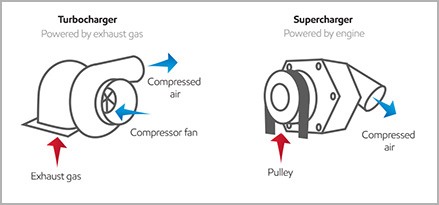The 25-Second Trick For Turbochargers
Table of ContentsSome Known Factual Statements About Turbochargers The 6-Second Trick For TurbochargersSome Ideas on Turbochargers You Need To Know
Modern turbochargers can use wastegates, blow-off valves and variable geometry, as gone over in later sections. In petrol engine turbocharger applications, boost pressure is limited to keep the entire engine system, consisting of the turbocharger, inside its thermal and mechanical design operating variety (turbochargers). Over-boosting an engine regularly causes damage to the engine in a variety of methods consisting of pre-ignition, overheating, and over-stressing the engine's internal hardware.Opening the wastegate enables the excess energy destined for the turbine to bypass it and pass directly to the exhaust pipe, therefore reducing increase pressure. The wastegate can be either managed manually (frequently seen in aircraft) or by an actuator (in vehicle applications, it is frequently controlled by the engine control unit).

The increased temperature from the higher pressure offers a higher Carnot performance. A minimized density of intake air is triggered by the loss of climatic density seen with elevated altitudes. Hence, a natural usage of the turbocharger is with aircraft engines. As an aircraft reaches greater altitudes, the pressure of the surrounding air quickly falls off.
In aircraft engines, turbocharging is commonly used to maintain manifold pressure as elevation increases (i. e. to make up for lower-density air at greater elevations). Given that air pressure decreases as the aircraft climbs, power drops as a function of altitude in generally aspirated engines. Systems that use a turbocharger to keep an engine's sea-level power output are called turbo-normalized systems.

5 inHg (100 kPa). Turbocharger lag (turbo lag) is the time required to alter power output in response to a throttle modification, saw as a hesitation or slowed when accelerating as compared to a naturally aspirated engine. This is due to the time needed for the exhaust system and turbocharger to generate the required increase which can likewise be referred to as spooling.
The smart Trick of Turbochargers That Nobody is Talking About
Superchargers do not suffer this issue, because the turbine is removed due to the compressor being straight powered by the engine. Turbocharger applications can be classified into those that need modifications in output power (such as vehicle) and those that do not (such as marine, aircraft, industrial vehicle, industrial, engine-generators, and locomotives).
Engine develops lower lag in a variety of methods: Decreasing the rotational inertia of the turbocharger by using lower radius parts and ceramic and other lighter products Altering the turbine's aspect ratio Increasing upper-deck air pressure (compressor discharge) and improving wastegate action Lowering bearing frictional losses, e. g., using a foil bearing click for info instead of a standard oil bearing Utilizing variable-nozzle or twin-scroll turbochargers Decreasing the volume useful source of the upper-deck piping Using several turbochargers sequentially or in parallel Utilizing an antilag system Utilizing a turbocharger spindle valve to increase exhaust gas flow speed to the (twin-scroll) turbine Sometimes turbo lag is mistaken for engine speeds that are below increase threshold.
This wait for lorry speed increase is not turbo lag, it is improper equipment choice for boost demand. turbochargers. Once the automobile reaches adequate speed to provide the needed rpm to reach boost threshold, there will be a far much shorter hold-up while the turbo itself develops rotational energy and transitions to favorable increase, just this tail end of the hold-up in achieving favorable boost is the turbo lag.
Below a specific rate of flow, a compressor produces irrelevant increase. This limits boost at a specific RPM, no matter exhaust gas pressure. More recent turbocharger and engine developments have actually progressively decreased boost thresholds. Electrical boosting (" E-boosting") is a new technology under development. It uses an electric motor to bring the turbocharger up to running speed quicker than possible using readily available exhaust gases.

The operating speed (rpm) at which there is sufficient exhaust gas momentum to compress the air going into the engine is called the "increase threshold rpm". Minimizing the "increase threshold rpm" can enhance throttle response - turbochargers. The turbocharger has 3 main elements: The turbine, which is generally a radial inflow turbine (however is practically constantly a single-stage axial inflow turbine in big Diesel engines) The compressor, which is almost constantly a centrifugal compressor The center housing/hub rotating assembly Lots of turbocharger installations use extra technologies, such as wastegates, intercooling and blow-off valves.
The smart Trick of Turbochargers That Nobody is Talking About
On the right are the braided oil supply line and water coolant line connections. Compressor impeller side with the cover removed. Turbine side housing got rid of. Energy provided for the turbine work is transformed from the enthalpy and kinetic energy of the gas. The turbine housings direct the gas flow through the turbine as it spins at approximately 250,000 rpm.
Frequently the exact same fundamental turbocharger assembly is readily available from the producer with multiple real estate choices for the turbine, and in some cases the compressor cover also. This lets the balance in between performance, action, and performance be customized to the application. The turbine and impeller wheel sizes also dictate the quantity of air or exhaust that can flow through the system, and the relative performance at which they run.
Measurements and shapes can differ, in addition to curvature and number of blades on the wheels. A turbocharger's performance is closely tied to its size. Big turbochargers take more heat and pressure to spin the turbine, creating lag at low speed. Small turbochargers spin quickly, however might not have the exact same efficiency at high acceleration.